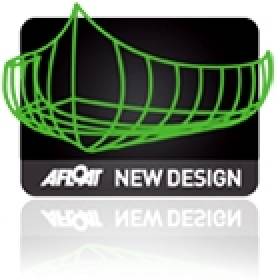Displaying items by tag: Caterpillar
#safehaven –A €1m-plus stealth style Irish built military vessel is creating waves along the Cork coast. 'Barracuda' is a new high speed Interceptor/Patrol vessel for military and law enforcement applications designed and built by Cork Harbour's Safehaven Marine.
Following a year and a half of design development and building work at its hi-tech manufacturing facility in East Cork, Cobh-based Safehaven Marine has unveiled the prototype of its latest design. And she's as mean as she looks!
Safehaven Marine is one of the world's top manufacturers of pilot boats and rescue vessels, and now the company hopes to use this new design to branch in to the world's military market.
The vessel can be produced at lengths of between 11 – 13m. Typical operational roles include patrol and surveillance duties around harbour installations and offshore anchorages, as well as high speed pursuit and apprehend when required. An array of both lethal and non lethal weapons can be carried concealed below decks in a separate compartment in the forward cabin, and raised when required. The vessel can be deployed by helicopter utilising its in-built lifting points on deck and at its 11m length, transported easily by ship or road.
Propulsion on the 11m version featured here is by conventional stern gear supplied by Clements Engineering and chosen for its weight carrying capabilities and durability, alternatively water jets can be fitted for higher speeds and low draft. Capable of maximum speeds of 40kts+ depending on the propulsion system and equipment installed, 'Barracuda' is fitted with a pair of Caterpillar C9 diesel engines rated at 560hp supplied by Finnings UK.
The innovative design of the vessel utilises various stealth technology's to produce a lower RCS (radar cross section), allowing it to operate with reduced degree of visibility to an adversary's radar. The design uses an innovative solution to weapon deployment. Various different types of both lethal and non-lethal weapons, including a remote control gyroscopically stabilised machine gun can be fitted to Barracuda. (A non functioning replica is fitted to the prototype featured here for demonstration purposes) In Barracuda the weapons are cleverly concealed below decks in the f/wd section of the superstructure, and are raised up to above deck level for deployment through large watertight carbon fibre hatches built into the f/wd cabins roof section. In this way when the vessel is in engaged in surveillance or patrol, the weapons are concealed and the vessels RCS signature is reduced. When the vessel is engaged in pursuit or apprehend modes, the weapons are raised for deployment.
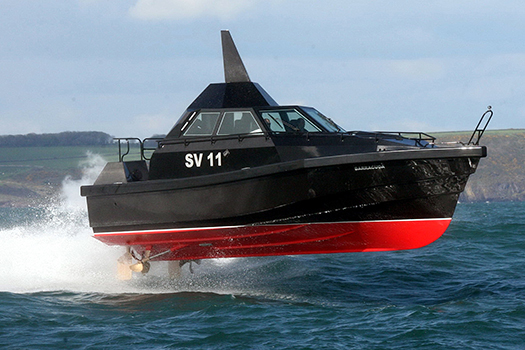
Airborne – Barracuda is powered by twin 560hp Caterpillars giving her lift off at a top speed of 38–knots for this Cork Harbour photo shoot
Another advantage being that the weapons are hidden when not in use for security, durability and covert reasons, as well as greatly reducing the vessels VCG when beneficial, such as in heavy weather. The superstructure and hull design utilises flat plane principles to its surfaces in its f/wd and side projections to deflect radar beams away from source, which together with specialized construction and outfitting, which include minimal metallic fittings exposed above decks, or where necessary being fully recessed. All of which combine to produce a vessel with a significantly lower than normal RCS.
The design however does not compromise on practicality or usability and provides for a high level of crew safety (wide side decks) for offshore boarding capabilities.
The vessel is constructed from advanced lightweight FRP cored composites, with extensive use of carbon fibre in its outfitting. Substantial in size yet lightweight Manuplas foam cored fenders with a polyurethane skin are used to minimise weight and offer maximum protection to the hull. The vessel can be moulded at lengths between 11m and 13m, and has a 4m beam, longer length versions benefit from a longer aft cockpit providing an increased working / crew area. The hull design below the waterline is an all new constant deadrise, twin chine deep V hull form capable of high speeds. A 22 degree deadrise at the transom and a wave piercing bow form, with a very fine wave cutting waterline entry at the bow of 70 degrees, which very effectively minimizes vertical accelerations at speed in waves, thereby maximising crew endurance. The hull provides exceptionally high levels of seakeeping abilities on all course, very much as one would expect from a builder renowned for its highly seaworthy pilot and S.A.R. vessels. The hull's special spray rail and twin chine arrangements provides for excellent spray suppression and on deck dryness, and her wide beam provides high levels of dynamic and static stability.
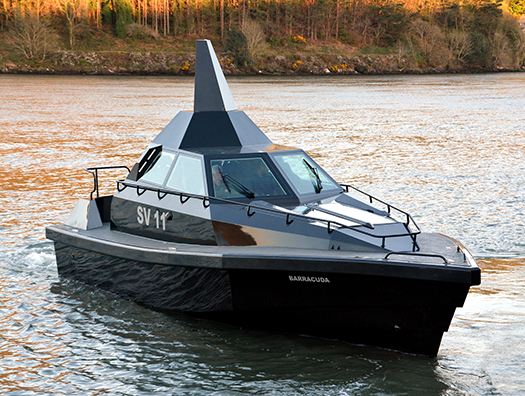
Not out of place in a James Bond film. This totally new hull has a constant deadrise Deep V with a wave piercing bow. Safehaven marine say they are just exploring its sea keeping abilities, but early reports say 'fantastic so far'! There is a really soft ride into a sea (see below) and good down wind in following seas even with such a fine bow
The design is capable of operating in up to sea state 7-8, and maintain operational speed in sea state 4-5, and can accommodate a crew of 4-6 in her main cabin, all on high tech shock mitigation seating supplied by X Craft, Holland.
As well as a full array of navigation equipment, a range of sonar equipment can be installed to monitor the underwater situation. FLIR Thermal and night vision infrared cameras are integrated for surveillance. A full digital Can Buss electrical system supplied by ETA has been integrated with all onboard systems controlled by touch screen computers at the helm and navigators positions, and expandable to potentially allow all crew members the ability to monitor and control the vessels navigation and onboard systems. Optionally ballistic protection can be incorporated to provide protection to the crew compartment utilizing lightweight composite ballistic panels. The front and side glass is ballistic and is directly bonded into moulded recesses without metallic frames. Barracuda will be produced alongside Safehaven's highly successful existing range of pilot, SAR vessels and patrol boats.
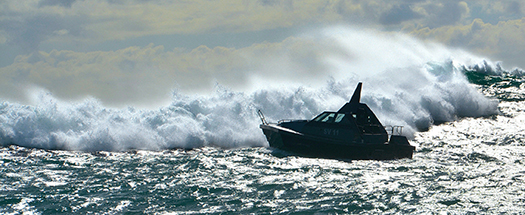
Big seas. Big test. 'Barracuda' during rough weather sea trials taking a pretty large breaking wave. Designed to have high levels of seakeeping and, depending on specification, she can be self righting as is the prototype here. Barracuda is 11m length overall. The top of the mast is 4.2m above the waterline so.... is this a 6m wave?...
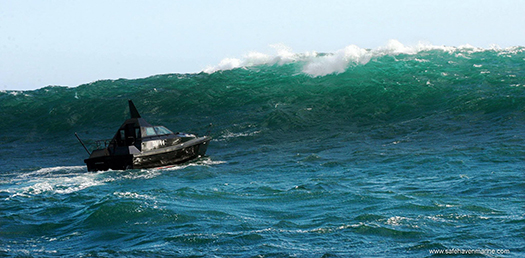
....Yep..... it sure is..... pass the sickbag please!


























